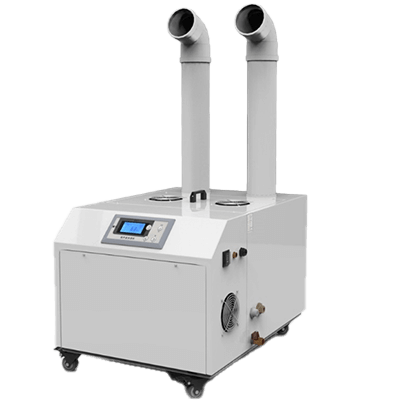What Is a Commercial Humidifier?

A commercial humidifier is a device designed to humidify large spaces, ensuring optimal humidity levels in areas such as offices, hospitals, stores, and nurseries.
Maintaining indoor humidity levels between 40-60% is considered ideal. Particularly in winter, indoor environments tend to become dry, increasing the risk of respiratory issues, viruses such as colds and influenza, and heightened pollen dispersion. Large-capacity humidifiers capable of humidifying places with a high concentration of people become essential in such scenarios.
Moreover, there are instances where rooms with specified humidity requirements, such as constant temperature and humidity rooms or measurement rooms, also benefit from humidification.
Uses of Commercial Humidifier
Commercial humidifiers are increasingly utilized in various facilities due to the growing emphasis on health-conscious practices.
- Medical and Welfare Facilities: Hospitals, clinics, elderly care facilities, etc.
- Office and Commercial Spaces: Offices, shops, restaurants, etc.
- Educational Facilities: Schools, kindergartens, training centers, libraries, etc.
- Factories: Printing factories, paper factories, control rooms, constant temperature rooms, etc.
- Exhibit Preservation: Museums and storage rooms
- Laboratories: Constant temperature and humidity rooms, measurement rooms, noise testing rooms, radio wave testing rooms, etc.
Principles of Commercial Humidifier
Commercial humidifiers employ various humidification methods, including vaporization, permeable membrane, steam, and water mist.
1. Vaporization Method
The vaporization method involves saturating porous materials such as filters with water and evaporating the moisture by passing air through them. While it has a low humidification capacity and consumes minimal electricity without a heater, it can lead to mold and bacterial growth, requiring frequent cleaning and filter replacement.
2. Permeable Membrane Method
In the permeable membrane method, only water vapor is released from a permeable membrane to humidify the passing air. It offers a high humidification capacity with low power consumption but requires regular cleaning of the permeable membrane.
3. Steam Method
The steam method involves heating water with a heater to produce steam for humidification. While it can humidify in large quantities, it comes with a disadvantage of high-power consumption. However, since it does not involve heating water, it prevents mold and bacterial growth. Regular cleaning is necessary due to the accumulation of scale. It operates independently of ambient temperature, ensuring stable humidification.
4. Water Mist Method
The water mist method includes ultrasonic and high-pressure spray types. Ultrasonic types create fine water particles by applying ultrasound to water, while high-pressure spray types eject water as a mist through nozzles. Despite providing a high humidification capacity with low power consumption, these methods can promote bacterial growth, necessitating regular cleaning. This method is relatively cost-effective.
5. Hybrid Method
The hybrid method combines multiple humidification methods to leverage their respective advantages. Examples include combinations of steam and vaporization or steam and ultrasonic methods, offering efficient humidification.
Types of Commercial Humidifier
Various types of commercial humidifiers are available.
Floor-standing types include fixed models and mobile types with casters. Types with automatic water absorption directly connected to the water supply eliminate the need for manual water supply.
Wall and ceiling-mounted types save space. Built-in devices and duct outlet types are aesthetically pleasing and are used in large-scale installations.
Selection of Commercial Humidifier
The selection of a commercial humidifier typically depends on factors such as the room’s floor area, humidification capacity, humidification method, and price.
1. Floor Area and Humidification Capacity
Humidification capacity is indicated by the amount of water vapor released per hour at room temperature 20°C and humidity 30%. Guidelines for humidification capacity are:
- Floor area: Wooden structure 30m2, prefab 50m2 … Humidification capacity of about 1,000ml/h
- Floor area: Wooden structure 50m2, prefab 80m2 … Humidification capacity of about 1,500ml/h
- Floor area: Museums, factories, commercial facilities with a floor area of 100m2 or more … Industrial humidification devices
2. Humidification Method
Humidification method selection is based on humidification capacity, power consumption, maintenance, compatibility with air conditioning systems, and price. While the water mist and permeable membrane methods provide high humidification with low power consumption, they require frequent maintenance. The steam method, using heater heating, is the most hygienic but has the drawback of high-power consumption.
3. Other Features
As commercial humidifiers have a high humidification capacity, it is essential to check the water supply method. For tank water supply, check water capacity, ease of removal, and installation. Automatic water absorption directly connected to the water supply is convenient and requires less effort.
Types that use DC motors for fan motors can reduce electricity costs.
Size is crucial; choose based on the installation location. Wall-mounted types that do not require floor space are also available.
Some products come with functions beyond humidification, such as air purification, sterilization, and antibacterial features. Additional features like humidity display, timer, and child lock can be convenient when in use.